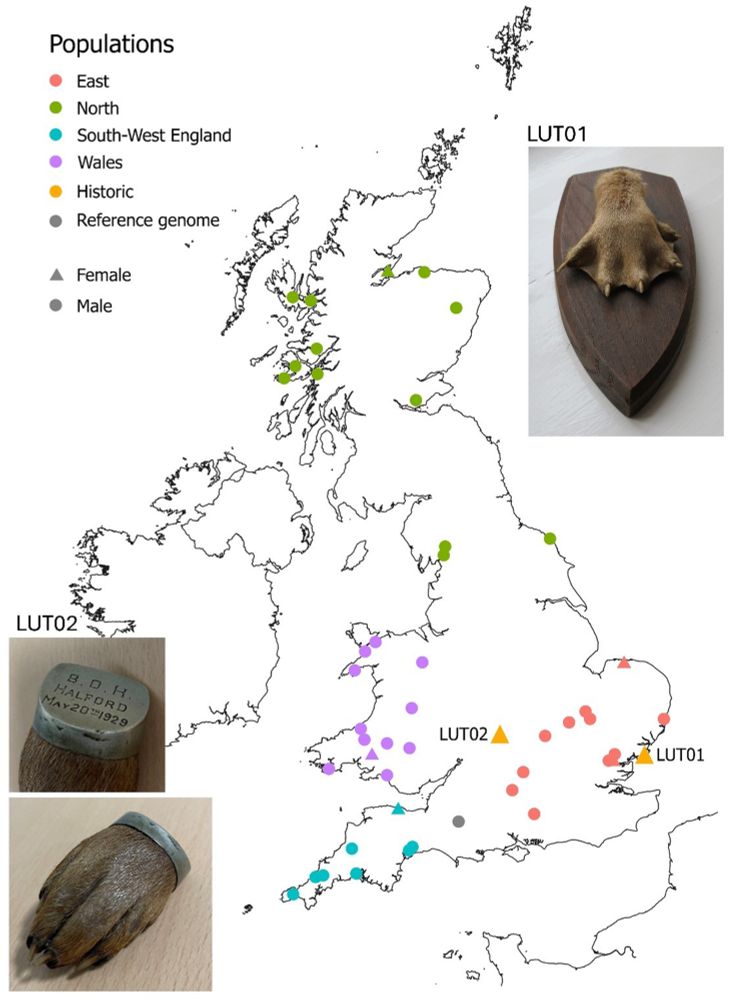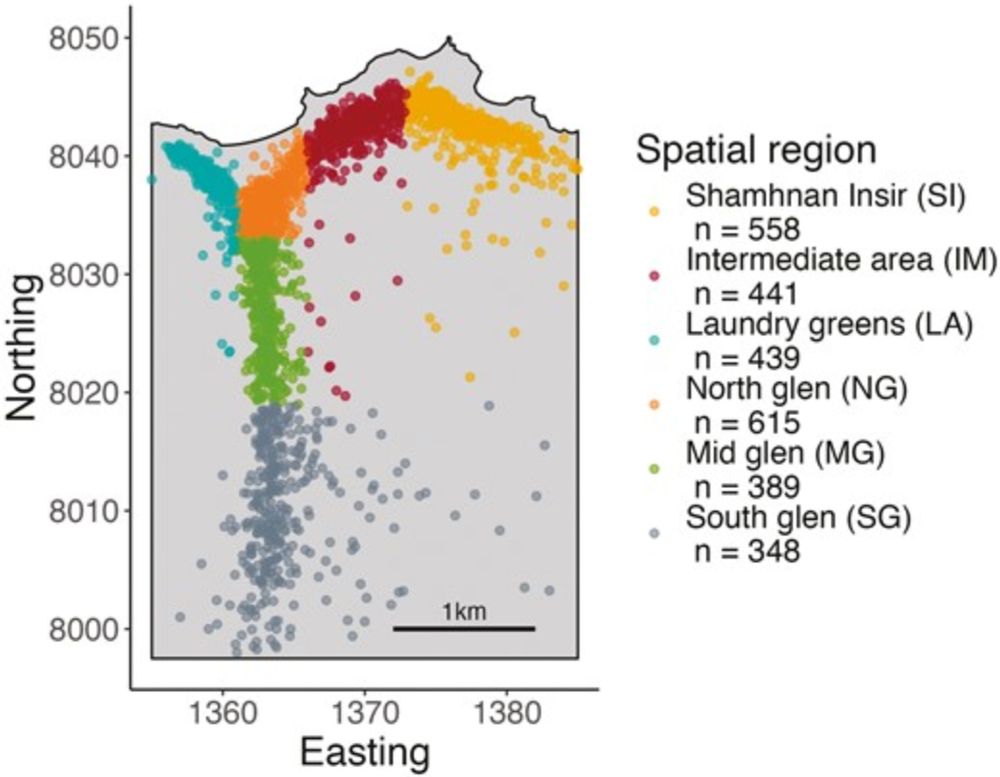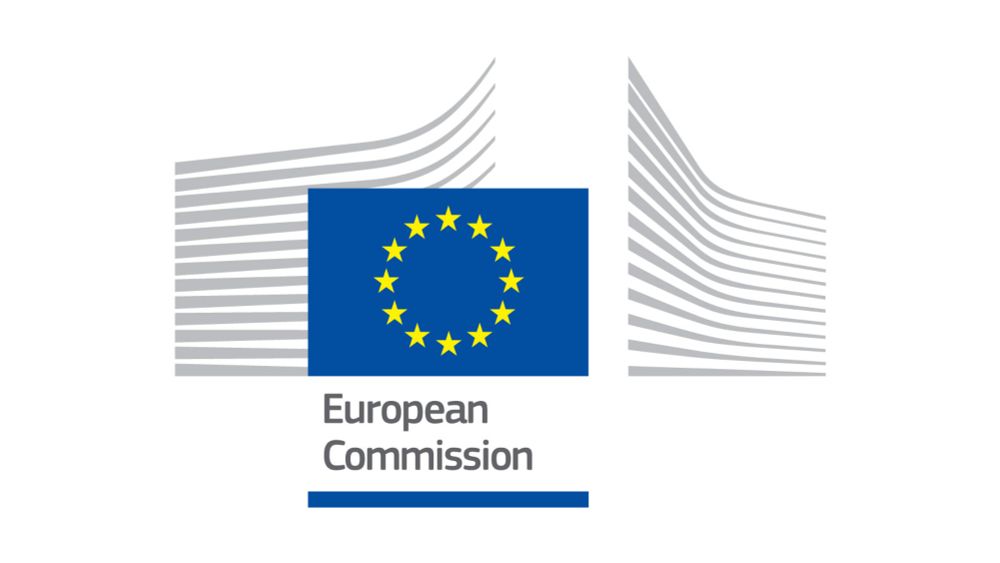Thanks for a brilliant visit to @amniotalab.bsky.social in @mfnberlin.bsky.social last week! Great to hear about everyones exciting projects and looking forward to working together in the future!
28.07.2025 08:42 — 👍 2 🔁 0 💬 0 📌 0
This research wouldn't have been possible without paw donations from Essex Wildlife Trust, the Cardiff Bio HPC team, and funding from NERC GW4+ and @embo.org
01.05.2025 13:05 — 👍 0 🔁 0 💬 0 📌 0
Thanks to all the Cardiff folk 🏴 @o-o-frank.bsky.social @otterproject.bsky.social @molecol-cardiffuni.bsky.social and the Copenhagen lot 🇩🇰 @hologenomics.bsky.social
01.05.2025 13:05 — 👍 2 🔁 0 💬 1 📌 0
🙏 Thanks to all my co-authors on this publication, I’m glad to have another chapter from my PhD out there, and the work that first brought me to Copenhagen!
01.05.2025 13:05 — 👍 0 🔁 0 💬 1 📌 0
🧬 While preliminary (n=2), these findings demonstrate the significant potential of museum specimens, and specifically otter hunting trophies, for temporal population genetic studies in this species and system, providing crucial context for contemporary conservation efforts.
01.05.2025 13:05 — 👍 0 🔁 0 💬 1 📌 0
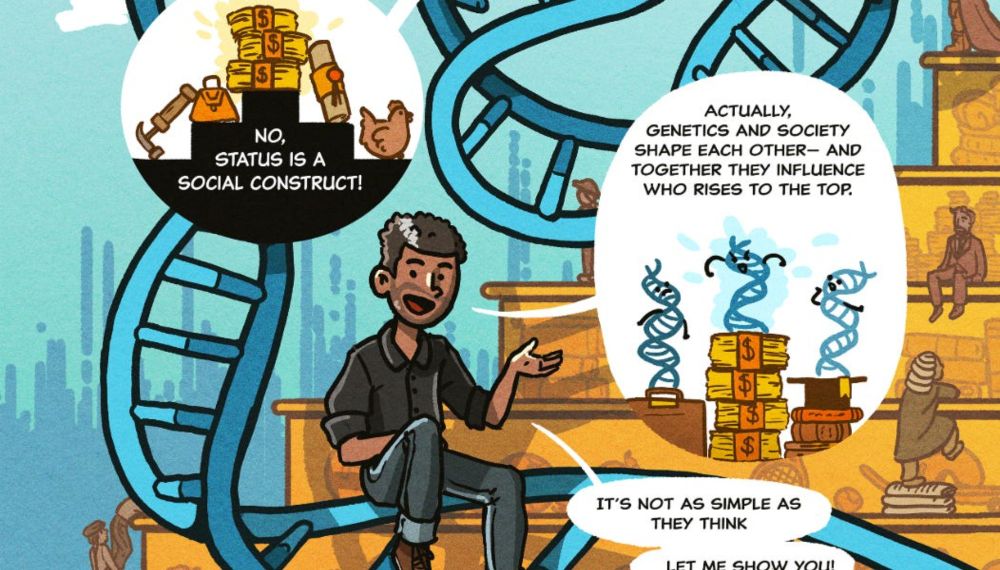
Genes, money, status... and comics
This week we published a big paper about nature and nurture, genes and socio-economic status. We think it’s important and deserves a broad audience, so here it is in graphic novel format.
Genes, money, status... and comics
New substack: I helped write @dr-appie.bsky.social's new paper about nature and nurture, genes and socio-economic status. We think it’s important and deserves a broad audience, so here it is in graphic novel format.
arutherford.substack.com/p/genes-mone...
29.03.2025 17:17 — 👍 114 🔁 42 💬 10 📌 6
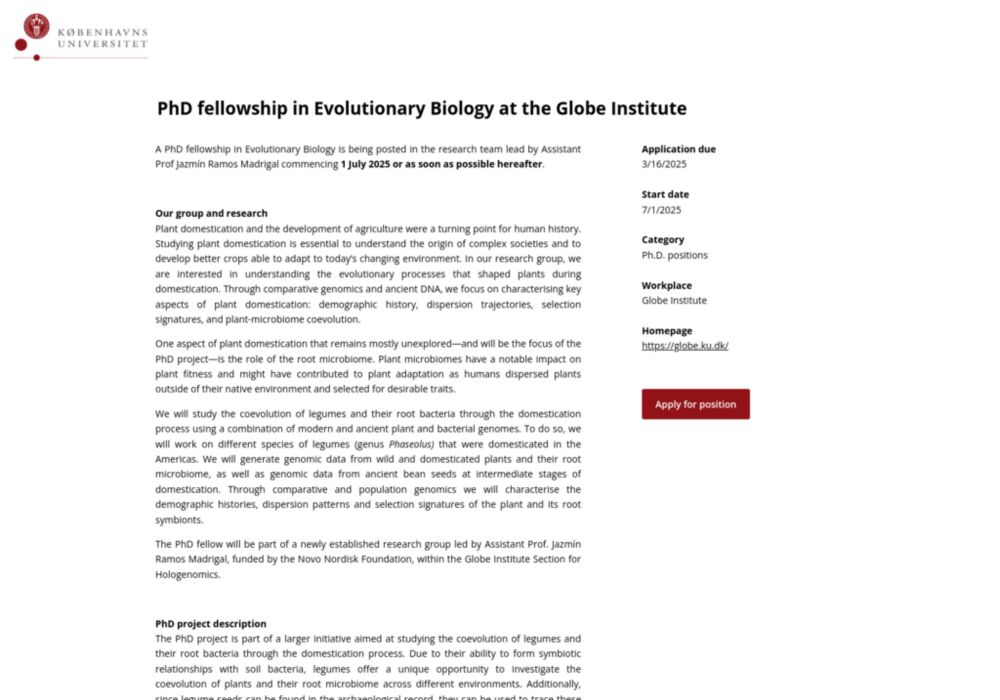
PhD fellowship in Evolutionary Biology at the Globe Institute
A PhD fellowship in Evolutionary Biology is being posted in the research team lead by Assistant Prof Jazmín Ramos Madrigal commencing 1 July 2025 or as soon as
PhD position in bean palaeogenomics!🌱
Join our group at @hologenomics.bsky.social , U. of Copenhagen. The PhD, funded by Novo Nordisk Foundation, will study bean domestication and its coevolution with rhizobia using ancient and modern genomes.
Apply by March 16: tinyurl.com/24uzrj2f
Please share!
12.02.2025 09:59 — 👍 26 🔁 27 💬 0 📌 1
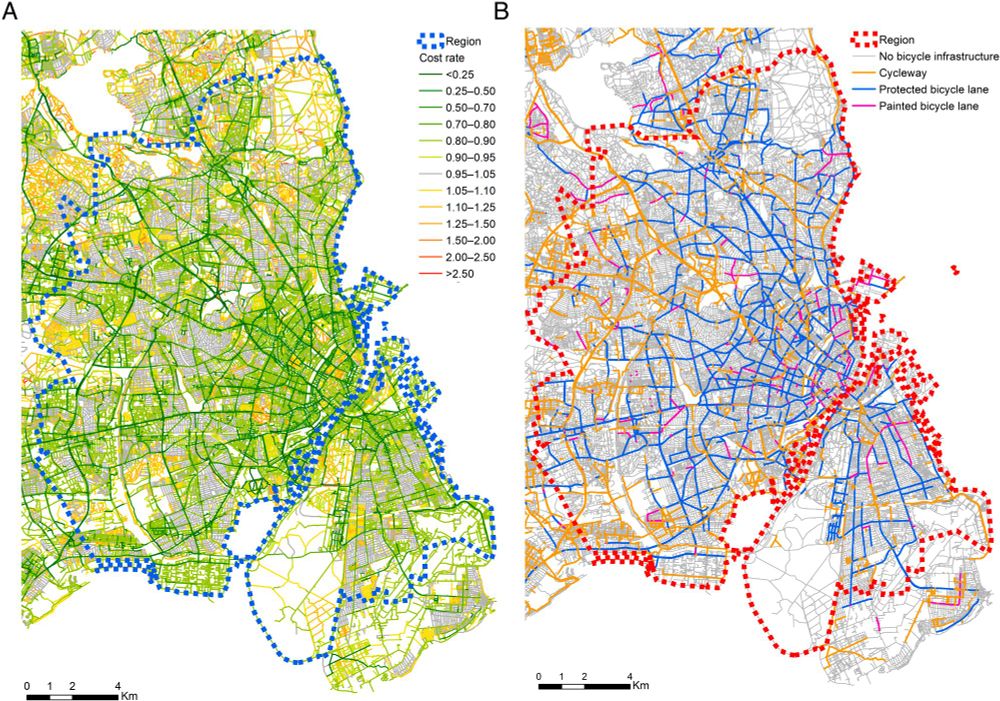
Bikeability and the induced demand for cycling | PNAS
To what extent is the volume of urban bicycle traffic affected by the provision of
bicycle infrastructure? In this study, we exploit a large datase...
Build the bike lanes, and they will be used!
Bikeability and the induced demand for cycling - doi.org/10.1073/pnas...
Also - look at the extent of protected bike lanes in Copenhagen!
17.01.2025 09:28 — 👍 6 🔁 1 💬 0 📌 0
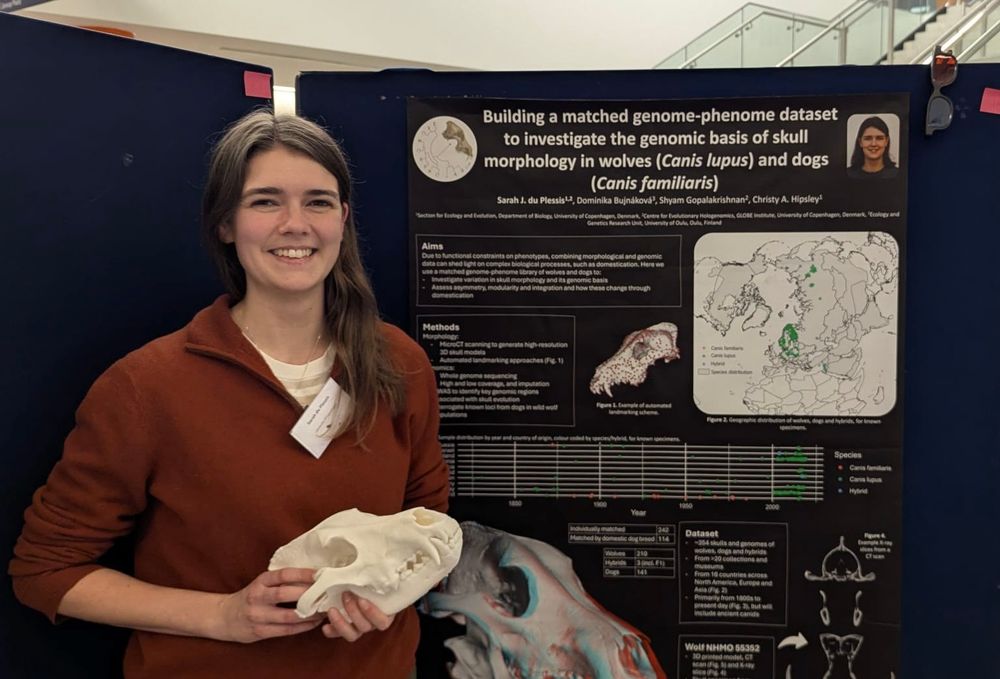
Thanks to everyone who stopped to chat (even if it was just to look at our skull!) 💀🧬🐺
08.01.2025 12:51 — 👍 5 🔁 1 💬 1 📌 0
Want to hear about wolf skulls? Come find my poster (hidden in the corner) at #PGG58 #PopGroup58
I can’t promise results (yet) but I do have a 3D printed skull and some cool visuals!
07.01.2025 09:11 — 👍 10 🔁 2 💬 0 📌 0
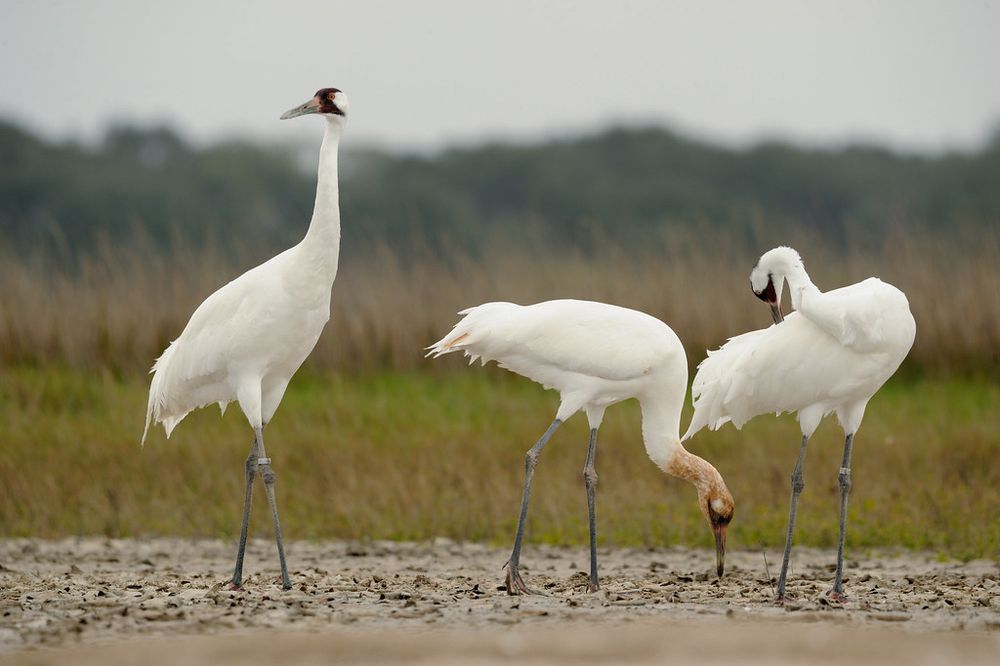
I'm super happy to share our newest preprint on whooping crane genomics 🐣🧬
🚨Persistent genomic erosion in whooping cranes despite demographic recovery🚨 www.biorxiv.org/content/10.1...
Extremely thankful to @hernmoral.bsky.social and all co-authors!
#conservationgenomics #genomics #whoopingcranes
17.12.2024 15:28 — 👍 66 🔁 34 💬 3 📌 4
We've got some exciting canidae work ongoing, so stay tuned... 💀🦊
11.12.2024 15:43 — 👍 1 🔁 0 💬 1 📌 0
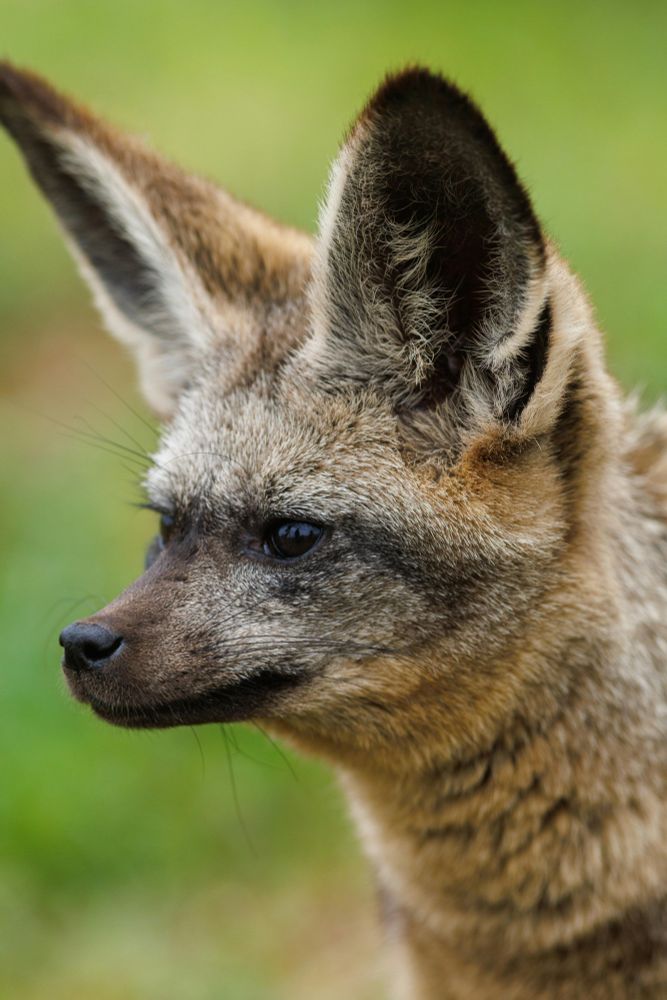
It was a bat-eared fox, Otocyon megalotis!
11.12.2024 15:41 — 👍 1 🔁 0 💬 1 📌 0
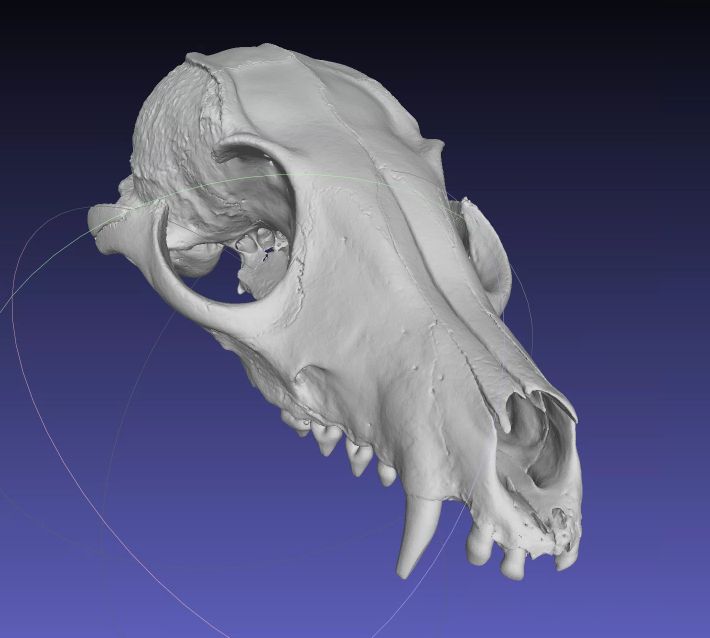
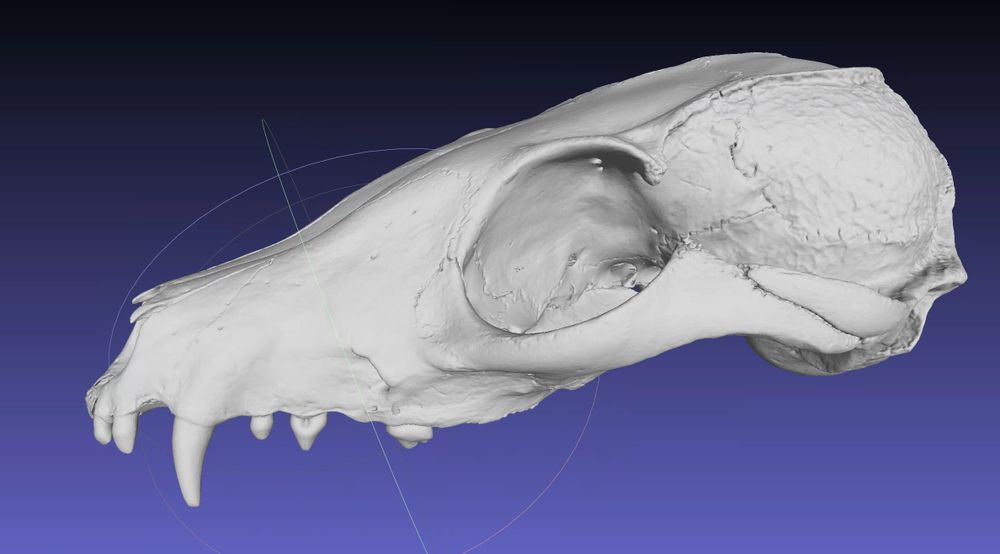
Guess the species? Here is a recently microCT scanned specimen from Copenhagen Zoological Museum, but can you work out what it is...
@evomorpholab.bsky.social
10.12.2024 12:16 — 👍 3 🔁 1 💬 1 📌 0
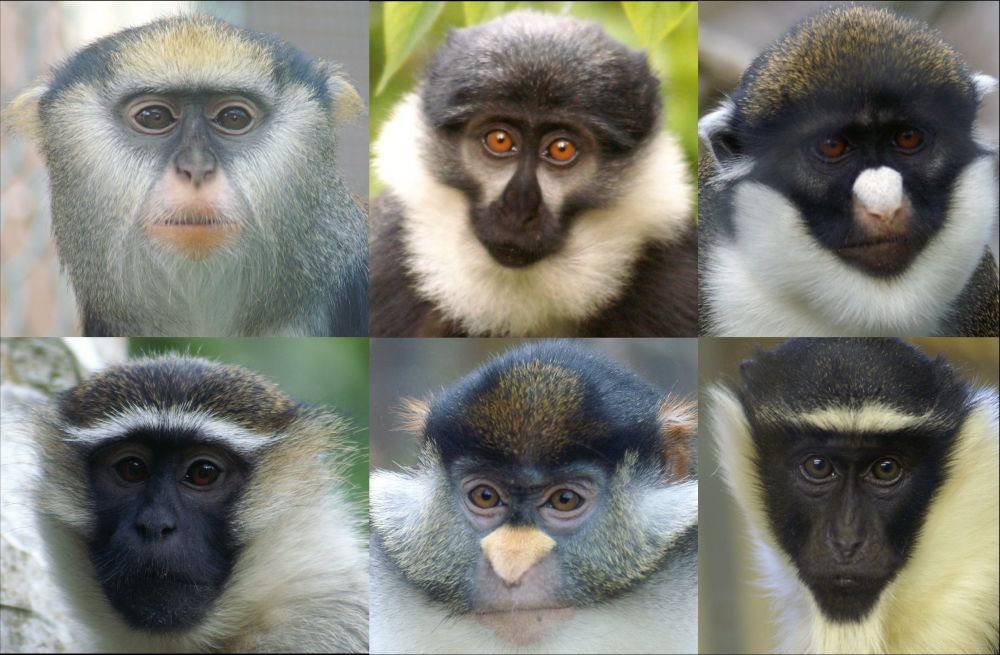
If you like genomics, speciation, and primates, this PhD position is for you! Unraveling the genomic architecture of speciation and gene flow in a crazy group of monkeys at U of Edinburgh . Do reach out with questions!
evol.mcmaster.ca/brian/evoldi...
01.12.2024 20:49 — 👍 80 🔁 75 💬 2 📌 11
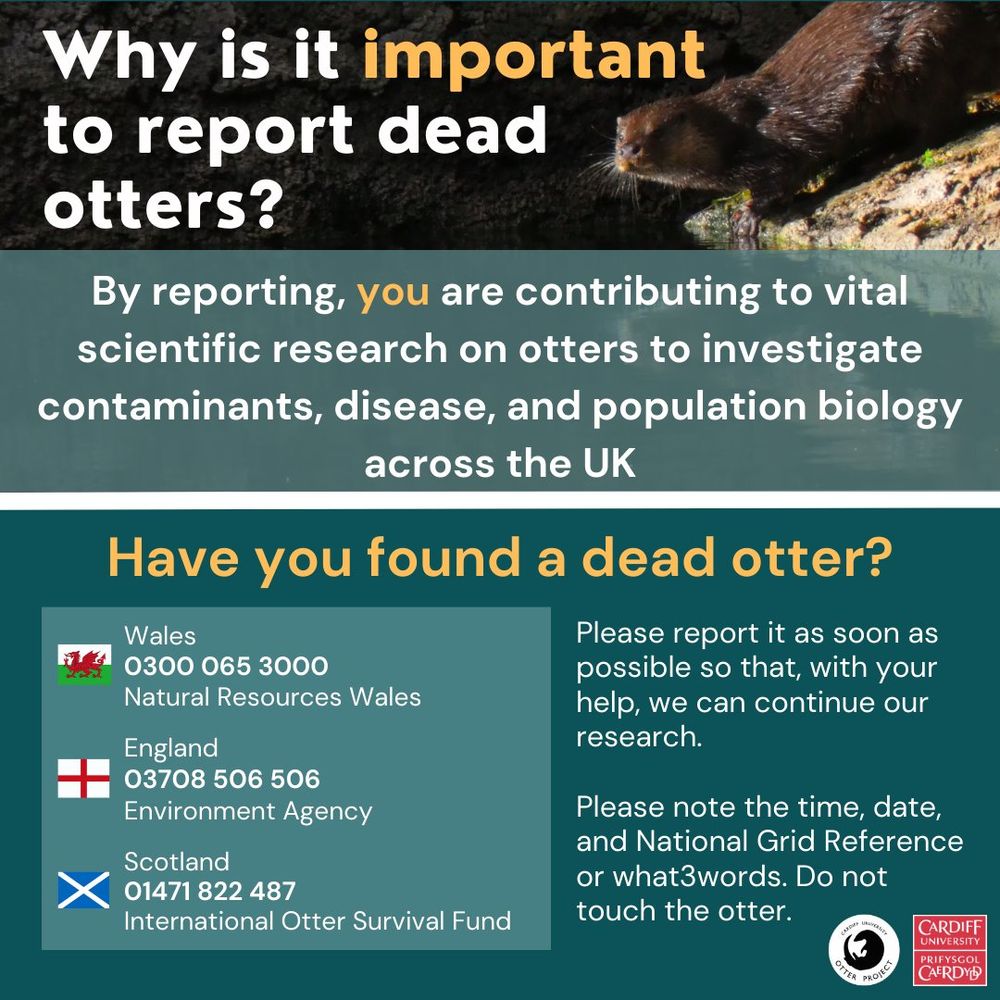
Infographic on "Why is it important to report dead otters?": By reporting, you are contributing to vital scientific research on otters to investigate contaminants, disease, and population population across the UK. Have you found a dead otter? Please report it as soon as possible so that, with your help, we can continue our research. Please note the time, date, and National Grid Reference or what3words. Do not touch the otter.
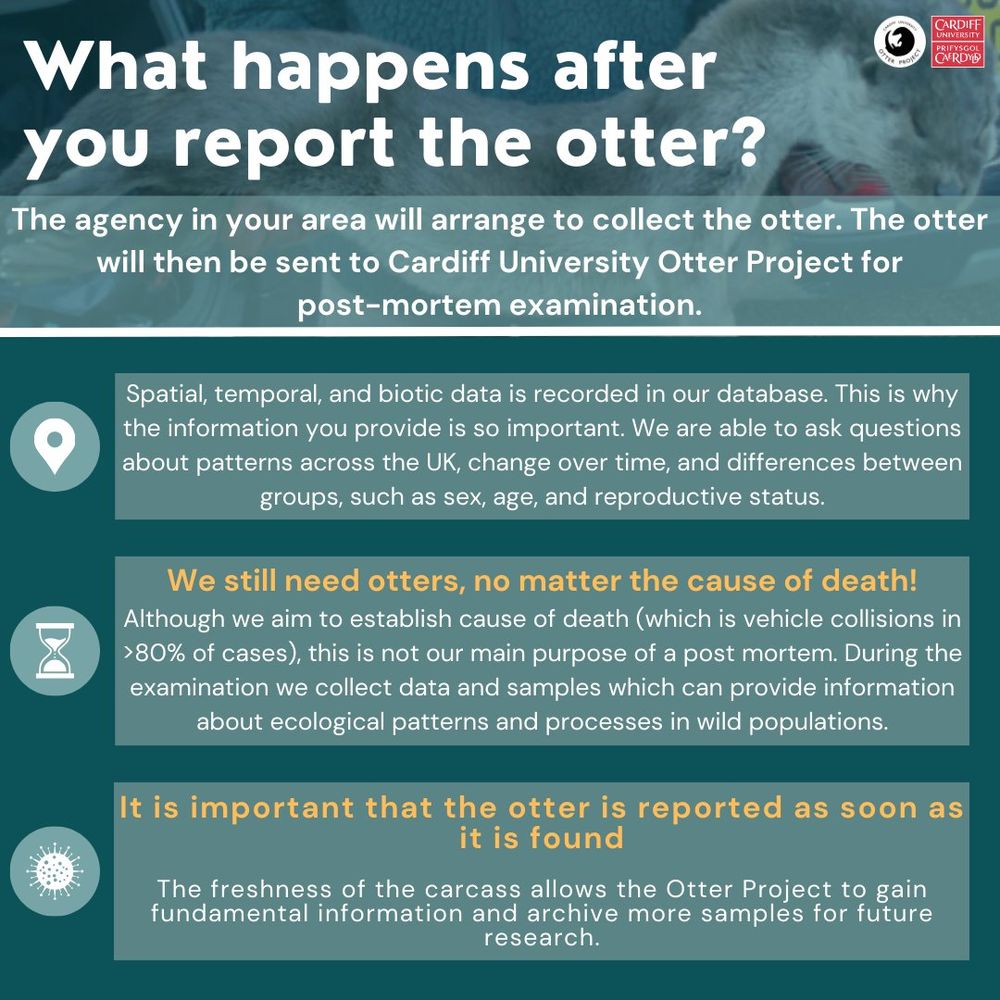
Infographic on "What happens are you report the otter?": The agency in your area will arrange to collect the otter. The otter will then be sent to Cardiff University Otter Project for post-mortem examination.
Spatial, temportal, and biotic data is recorded in our database. This is why the information you provide is so important. We are able to ask questions about patterns across the UK, change over time, and differences between groups, such as sex, age, and reproductive status.
We still need otters, no matter the cause of death! Although we aim to establish the cause of death (which is vehicle collisions in >80% of cases), this is not our main purpose of a post mortem. During the examination we collect data and samples which can provide information about ecological patterns and processes in wild populations.
It is important that the otter is reported as soon as it is found. The freshness of the carcass allows the Otter Project to gain fundamental information and archive more samples for future research.
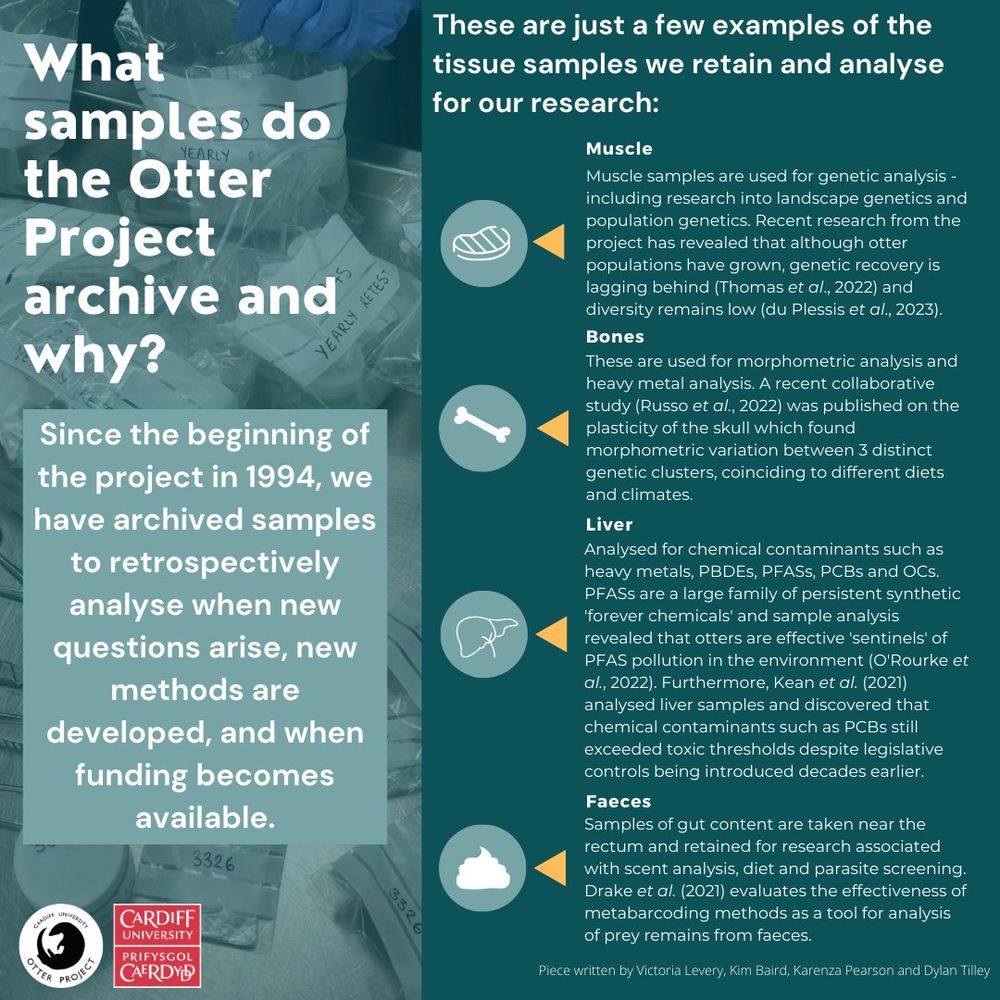
Infographic explaining: "What otter samples do the otter project archive and why?"
Since the beginning of the project in 1994, we have archived samples to retrospectively analyse when new questions arise, new methods are developed, and when funding becomes available.
These are just a few examples of the tissue samples we retain and analyse for our research:
Muscle samples are used for genetic analysis including research into landscape genetics and population genetics. Recent research from the project has revealed that although otter populations have grown, genetic recovery is lagging behind, and diversity remains low.
Bones are used for morphometric analysis and heavy metal analysis. A recent collaborative study was published on the plasticity of the skulls which found morphometric variation between 3 distinct genetic clusters, coinciding to different diets and climates.
Liver is analysed for chemical contaminants such as heavy metals, PBDEs, PFASs, PCBs, and OCs. PFASs are a large family of persistent synthetic "forever chemicals" and sample analysis revealed that otters are effective sentinels of PFAS pollution in the environment. Furthermore, we have found that chemical contaminants such as PCBs still exceeded toxic thresholds despite legislative controls being introduced decades earlier.
Samples of gut content are taken near the rectum and retained for research associated with scent analysis, diet, and parasite screening. We have evaluated the effectiveness of metabarcoding methods as a tool for analysis of prey remains from faeces.
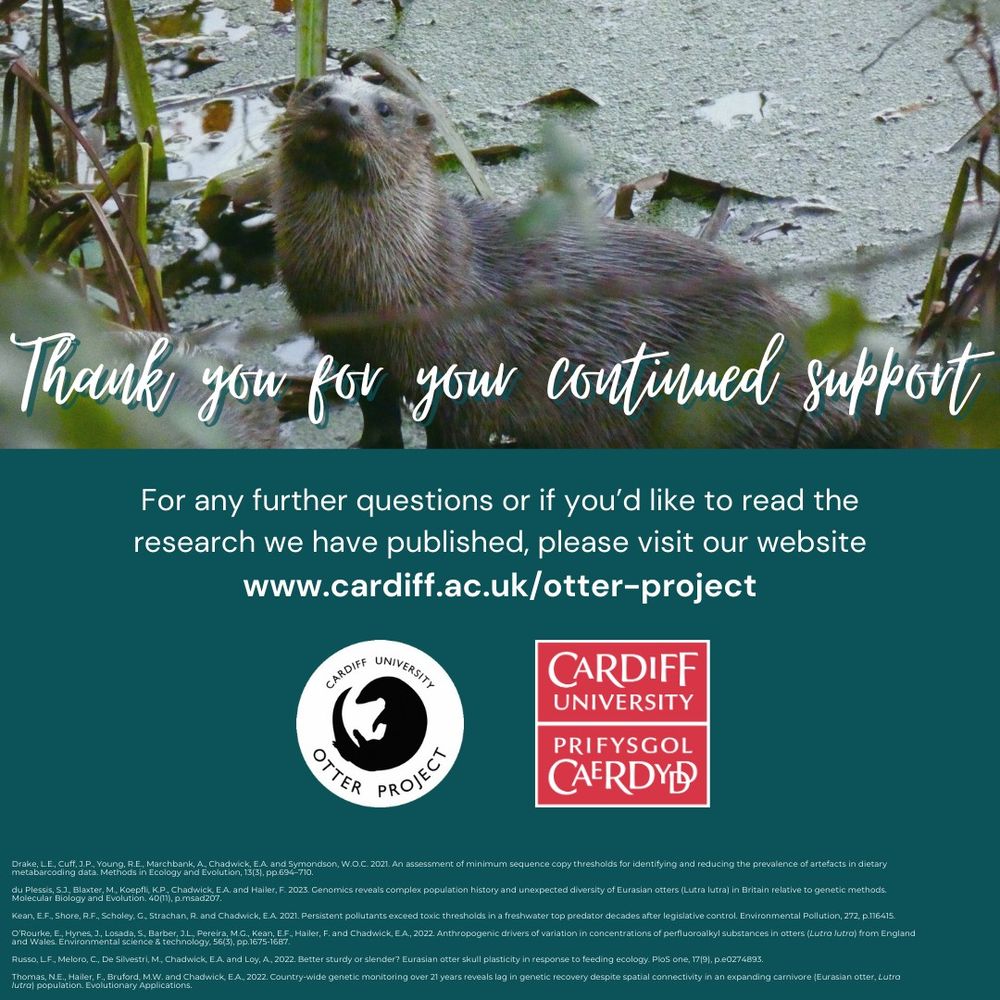
Thank you for your continued support (featuring a picture of a eurasian otter on a river bank). For any further questions or if you'd like to read the research we have published, please visit our website: www.cardiff.ac.uk/otter-project
We post mortem otters found dead in Wales, England, and Scotland. If you have found a dead otter please contact the relevant organisation below:
• Wales: Natural Resources Wales 0300 0653000
• England: Environment Agency 03708 506506
• Scotland: International Otter Survival Fund 01471 822487
28.11.2024 16:01 — 👍 1 🔁 1 💬 1 📌 0
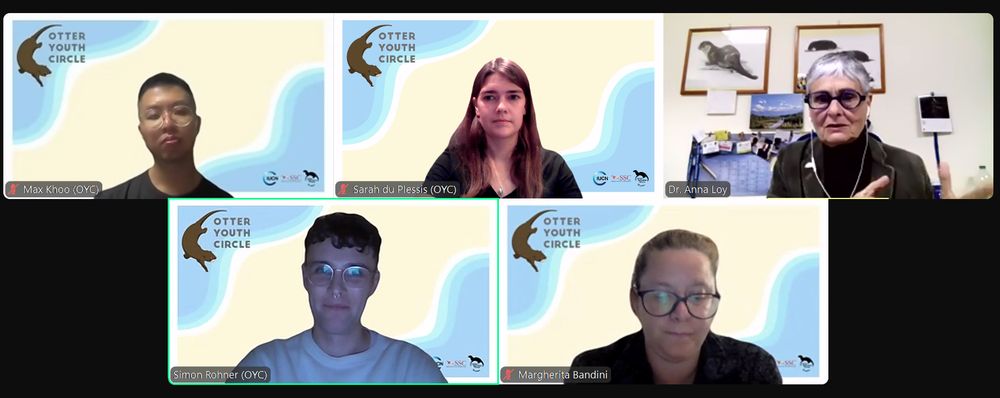
Thanks to our speaker, Dr Anna Loy, for yesterdays Otter Youth Circle webinar on otter species' vulnerability to climate change! Thanks to both Otter Specialist Group and the rest of the Otter Youth Circle team. Let us know if you'd like details for the next in the series...
28.11.2024 15:22 — 👍 3 🔁 0 💬 0 📌 0

Scene of lake in an urban context with sunset behind
4-year funded PhD: Urban green space as refuge for people and disease vectors under climate change: a double-edged sword
Very interdisciplinary (topic, approach, team): vector ecology, human behaviour; mapping and modelling!
www.findaphd.com/phds/project...
Application deadline: 6 Jan 2025 (1/2)
25.11.2024 11:53 — 👍 82 🔁 40 💬 1 📌 0
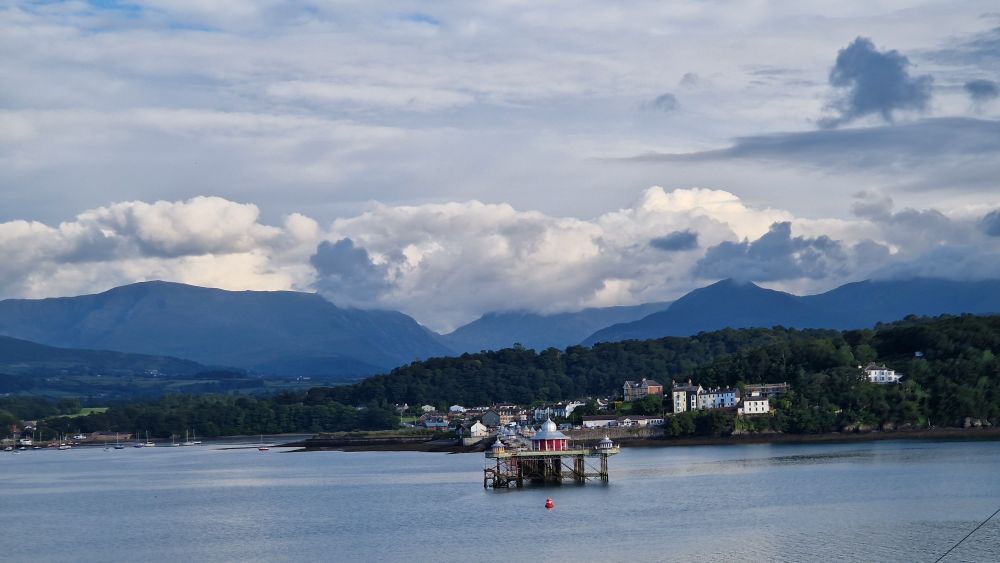

Please share our
new Erasmus-funded MSc programme GLOBE (Global Change Ecology & Biodiversity Management). Scholarships include 1400 E/month stipend. Spend time in Bangor (beautiful N. Wales), Madrid, Lisbon & Mexico!
globe-master.eu
17.11.2024 07:47 — 👍 21 🔁 17 💬 0 📌 0
Who should you nominate as reviewers for your manuscript? After a long chat with a post-grad it appears that there's a lot of misguided advice out there. Thread 👇
22.11.2024 11:05 — 👍 348 🔁 144 💬 18 📌 42
Postdoc at Uppsala university. Doing temporal population genomics in humans, as well as endangered mammals and birds.
BBSRC PhD at the University of Nottingham. Genomic perspectives on the global expansion of the house sparrow.
PhD fellow at UCPH and UofYork studying ancient DNA 🧬🇳🇱🇬🇧
PhD student
Palaeontology 🦌🦬🦒
Martin Luther Universität Halle Wittenberg
Museum für Naturkunde Berlin
Follow us for real science and research stories beyond the sky! 🦋
Johannes Müller and Faysal Bibi research group at the
@mfnberlin.bsky.social
check out our web: https://amniota.org
#paleontology #vertebrates #morphology #3D
Paleobiologist researching squirrel & rodent evolution. Humboldt fellow at Museum für Naturkunde Berlin. Spanglish posts.
#StopGenocide🍉 #DiversityInScience #Feminism #StopClimateChnge #Music
Conservation genetics & population genomics of tropical island populations, occasionally ancient DNA, phylogenetics, biogeography, & biodiversity informatics, mostly mammals 🐗🐂. She/her. 🇲🇨. X/Twitter previously sagitaninta.
MBE publishes fresh insights into the patterns and processes that impact the evolution of life at molecular levels.
🔗 academic.oup.com/mbe
🏠 @official-smbe.bsky.social
🤝 @genomebiolevol.bsky.social
#evobio #molbio #science #biology #societyjournal
Specialist training in applied statistical methods for researchers in ecology, biology, and environmental sciences.
Courses are taught by leading academics and designed to support postgraduate students, early-career researchers, and established scientists
Evolutionary biologist | #Conservation #Genomics #PopGen | #Tortoises et al 🐢🐸🐳🐻🐉🦋
Postdoc at Uppsala University, Sweden. Evolution| PopGenomics| Vertebrates| aDNA 🧬
PhD researcher studying otters and buzzards as sentinels for chemical pollution @ECORISC_CDT at @cardiffuni 🦦🧪 outdoor adventurer and animal lover ⛰️🐝
Curator of Herpetology & Associate Professor of Vertebrate Zoology at Natural History Museum of Denmark • ERC StG: GEMINI • Co-host of SquaMates Podcast and AnatomyInsights on Youtube • He/Him
Mexican Historian & Philosopher of Biology • Postdoctoral Fellow at KU Leuven (@theramseylab.bsky.social) • Book Reviews Editor for @jgps.bsky.social • #PhilSci #HistSci #philsky • Escribo y edito • https://www.alejandrofabregastejeda.com
Head of Biodiversity Monitoring | SMNS & Univ. of Hohenheim 🌿🪲🔬🧬
Passionate about species formation & persistence in a changing world. 🏃🏻♂️🌍
Committed to mentoring future scientists & engaged citizens. 🎓💡
https://biodiversitysmns.wixsite.com/rpereiralab
Fresh off my PhD in museomics studying New Guinean birds @ Naturhistoriska Riksmuseet & Stockholm University | Bioinformatics, population genomics, phylogeography | First gen | 🇵🇱x🇩🇪 Hybrid | Occasional nerdy arts
Ad Astra-Assist. Prof at UCD. Young Academy Ireland. https://t.co/ZQ4XYYxM7H
Ancient DNA, goats, sheep (begrudgingly), pathogens, climate, MTG, The Traitors.
I watch too many films: http://letterboxd.com/GingerHowley
He is openly gay (citation needed)
